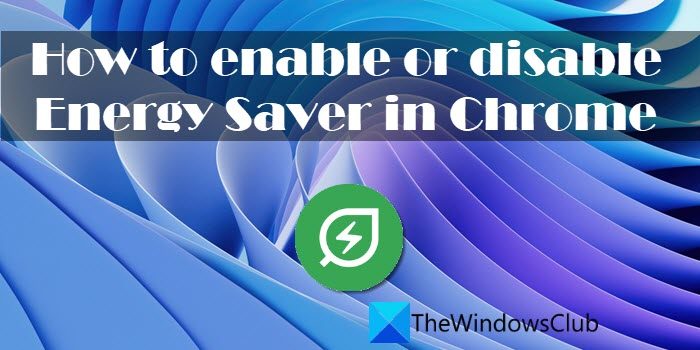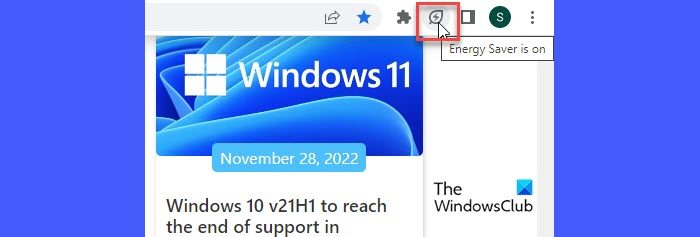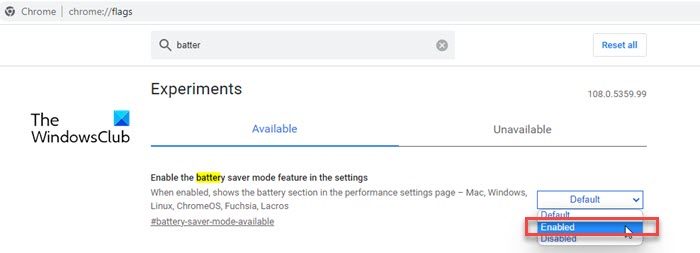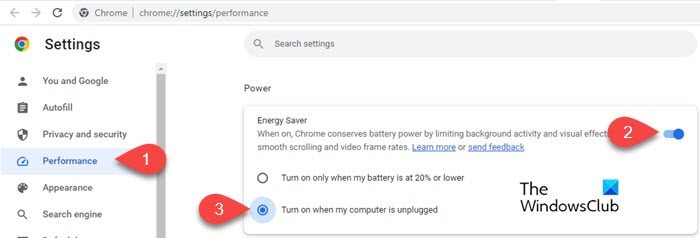In this post, we will show you how to enable or disable Energy Saver Mode in Chrome. Google Chrome is well known for using a lot of system resources and consuming the most battery among other browsers. To fix this, Google is constantly trying to roll out new features to improve the performance of the Chrome browser. Recently in its latest version, Google Chrome has introduced a new Energy Saver Mode to extend the battery life of devices when they’re running low on it.

Energy Saver, when enabled, saves the battery when it reaches a level of 20% or low, or when the device is unplugged, by limiting the background activity of Chrome and limiting the visual effects (smooth scrolling, video frame rate, etc.) on websites that play videos and animated content.

Energy Saver also known as Power Saver or Battery Saver mode, is currently available as an experimental feature and can be enabled through special flags in Chrome settings. To turn on power saving mode in Chrome, you need to configure a hidden setting that’s available on Chrome’s flags page. Please note that by enabling hidden features you risk your browser’s privacy and security and may lose browser data.
Enable or Turn on Energy Saver mode in Google Chrome

To enable Energy Saver in Google Chrome, follow the steps listed below:
- Open a new tab in the Google Chrome browser.
- Type chrome://flags/ in the address bar and press the Enter key.
- Type ‘battery’ in the Search flags search box on top. Search results will appear.
- Look for the ‘Enable the battery saver mode feature in the settings’ option and click on the dropdown next to it.
- Select Enabled from the dropdown.
- Click on the Relaunch button that appears with a message at the bottom to apply changes.
Select when to Activate Energy Saver mode in Chrome

- Click on the menu icon (three vertical dots) in the top right corner of the browser window and select More tools > Performance. If you don’t see the Energy Saver option under the Performance tab, the feature has not been rolled out to your device.
- Make sure the Energy Saver toggle button is set to On.
- Select one of the option buttons available below the setting. You may either activate the Energy Saver mode only when your device’s battery is at 20% or lower, or when your computer is unplugged.
As soon as you turn this setting on, the energy saver icon will appear in the top-right corner of your browser window as an implication that the Energy Saver mode has been activated.
When not activated (either when your device is plugged in or when the battery level is more than 20%), the icon will disappear from your browser, even though the setting remains turned on.
How to disable Energy Saver mode in Google Chrome
To disable the Energy Saver mode:
- Click on Google Chrome’s menu icon.
- Select the Performance option from the More tools menu.
- Under Power options, turn off the Energy Saver toggle button.
You can also head back to chrome://flags/, navigate to the ‘Enable the battery saver mode feature in the settings’ flag and change its value to Disabled. The changes will apply when you relaunch Chrome.
Also read: How to enable Memory Saver Mode in Chrome
Is Google Chrome killing my battery?
If you’re a heavy Chrome user (you keep several tabs open while working on Chrome browser, use several extensions and add-ons, or keep watching videos back to back), then Chrome is certainly draining your system’s battery. This is because Chrome uses an extensive amount of RAM to provide you with a seamless browsing experience.
Read Next: Restart Chrome and continue where you left off without losing tabs.